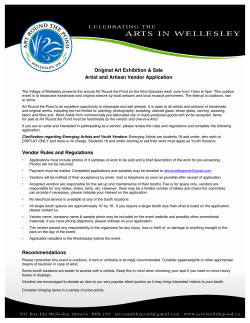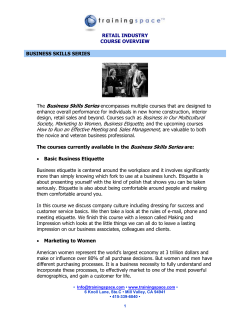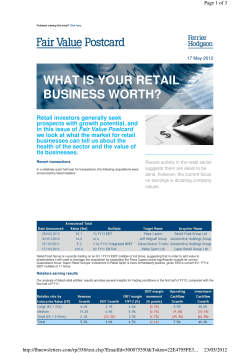
What is AR Anyway? Augmented Reality: A Retail Marketing Game C...
What is AR Anyway? Augmented Reality: A Retail Marketing Game C... 1 of 5 http://www.retailernowmag.com/what-is-ar-anyway/ home magazine blog read subscribe advertise contact Type here What is AR Anyway? Written by Sue Masaracchia-Roberts in Advertising & Marketing, Featured Stories, Technology 1 January 14, 2014 In every industry, marketing and advertising must adapt to keep pace with changes in technology trends and in the ways consumers digest information. As messages bombard people from the moment they turn on their electronic devices, advertisers must work to reach consumers in unique ways they can relate to. Augmented reality (AR) does just that, as it injects a playfulness—an element of the unexpected—into an everyday product or experience. “Augmented reality is a new, innovative technology that provides ways for consumers to experience a product like they never have before,” said Ryan Darbonne, marketing director at AR provider Gravity Jack. “It packs an extremely powerful, low-risk product experience for customers. It allows them to interact with, experience, share or discuss a product virally with their close networks on social media. This is an extremely rare opportunity to provide a fully immersive and completely new experience. It is a perfect 1/28/2014 2:53 PM What is AR Anyway? Augmented Reality: A Retail Marketing Game C... 2 of 5 http://www.retailernowmag.com/what-is-ar-anyway/ fit.” AR enhances someone’s view of the world by using a device, be it an iPhone, a webcam, any mobile device or even glasses with a camera and/or computing power. The real world is replaced by adding or changing the data about what is being seen. “Augmented reality is just a technology that allows you to learn something,” said user Troy Dunn, president of Dunn&Co, a Florida-based advertising agency. “It uses something like a mobile device that is a portal into a world that really isn’t there, but it is once you go to that portal screen. Augmented reality allows you to manufacture an experience for a customer in a way you could never do in the real world space, affordably or any other way. We are now able, with AR, to create a portal that transports the user into this very unusual and unexpected experience space.” AR’s beginnings and applications First envisioned by Wizard of Oz creator L. Frank Baum around 1901, the idea of projected reality actually was patented as a “Sensorama Stimulator” by cinematographer Morton Heilig in 1962. The actual term “augmented reality” was first coined in the early 1990s, reputedly by Boeing researcher Tom Caudell, for use by workers to show how to separate bolts. From its modest beginnings, where it added audio, animation, video or graphic layers, AR has progressed to a time that allows readers to use custom designed software and a webcam to see 3D images and video content. One of AR’s pioneers, Layar, began in the AR industry nearly five years ago. Co-founder and U.S. general manager Maarten Lens-FitzGerald said the company saw the possibility of a platform where anyone could create and experience AR through one app: “On one hand science fiction books gave us the idea, as well as Japanese anime. These showed us how the near future reality could be part of our current world. We see it as a way to view the world differently—an amazing way to link paper/print products to their digital experience and their world, to bring people closer and create a better experience.” Marxent Labs CEO Beck Beseker agreed and noted that in the retail space, AR can be invaluable. “The whole point of retail is to make advertising actionable,” said Beseker. “That is what AR does.” As an example, this vendor explained, “You get a catalog or a magazine in the mail and you really like a [specific] product. Instead of dog-earing or ripping out the page, you hold your phone over it. It takes you online and you buy it. It is like a big shortcut hyperlink. The greatest benefit to retailers will be to make the entire store actionable.” But AR is more than just a service that links users to a website. According to Darbonne, stores can base their campaigns on unique user information like past purchases to provide product videos and images of new items they may find interesting—effectively allowing physical stores to sell products to shoppers in the shopper’s own home. 1/28/2014 2:53 PM What is AR Anyway? Augmented Reality: A Retail Marketing Game C... 3 of 5 http://www.retailernowmag.com/what-is-ar-anyway/ IKEA’s entire 2013 and 2014 catalogs exemplify this. A customer can open to a page, put the IKEA catalog on the spot in their home where the consumer may want to place a piece of furniture, for example, and then point their mobile device at that piece on the page. An image will appear to size in whatever color or fabric the consumer wants to see. This allows them to know before ever going to the store if the piece fits in their space and if they will like it when it arrives. IKEA retail services communication manager Mattias Jöngard said, “We want the IKEA catalog to be a great source of inspiration as well as a tool to show solutions to people’s dreams and needs. We’ve tied [this catalog] to a mobile app since 2011 and started to use AR for the 2013 [issue]. Customers see their portable devices as tools. The [2013] app downloaded 9.7 million times throughout the year.” Byron Colby, senior vice president of digital commerce at retailer Cornerstone Brands, began to work with Marxent Labs when he realized his customers wanted to meld the impact and inspiration of the print catalog with the benefits of mobile online use, like social sharing, product reviews, images and video and the ability to track favorites. “Catalogs are inspirational with great imagery, but are static,” Colby said. “We needed to find [a way] to make them more dynamic and accessible while on the go. AR has the potential to do that. Customers are demanding a lot more. What we’ve done using this tool is [allow you to] point your phone at a catalog and instantly see couches, their different colors [and] video.” AR technology is also effective at trade shows and other events. Dunne explained, “Our intro into using AR technology had to do with exploring how to make intriguing connections to our customers’ customers at trade shows. A customer will come into our booth space and we’ll hand them a mobile device like an iPad, and we’ll use AR to bring the booth space to life. We’ll actually put graphics around the space at the booth, whereas in the past, a booth was always populated by artwork and messaging. One of the things we envision is to make that booth into anything you want it to be. In the future, it could be a different booth space for different audiences. Rather than having a theme or one key message, you could have multiple pathways of key messages. We can program something in such a way that when you hand an iPad to somebody, they can select where they are from (country or industry) and that will automatically give them a different booth experience from somebody else.” Finding the right vendor to create an effective experience “Custom software, including augmented reality, is perhaps the truest example of ‘you get what you pay for,’” Darbonne explained. “The right vendor will bring three critical things to the table: experience, vision and comprehensive delivery. If you select a team that doesn’t [understand these capabilities], you run a very high risk of gimmicky campaigns with low impact and high attrition.” Hollis Murphy, the webmaster and graphic designer for industrial manufacturer Sumitomo Machinery Corporation of America (SMA), contracted with Gravity Jack to help develop its application and transform it into a mobile version. “What this has done,” 1/28/2014 2:53 PM What is AR Anyway? Augmented Reality: A Retail Marketing Game C... 4 of 5 http://www.retailernowmag.com/what-is-ar-anyway/ Murphy said, ”is pull back the curtain and reveal what we have to offer rather than distract our customers. It’s gotten the industry excited. Our sales reps, customers and people can really see and engage with products instead of flipping through a catalog. It gives a memorable experience.” Colby further suggested that a partner company should help educate people how to use it and make it as simple as possible. It needs to pass his mom test: “If you cannot explain it to your mom, it’s not going to fly.” Before looking for an AR partner, Lens-FitzGerald encourages businesses to know their objective and how much time they have to reach their objective, and ensure those objectives are smart. Consider how much budget you have and who your target group is. Are your users mobile savvy? See what is best for you based on marketing basics. “Begin with a small project, like an event,” said Beseker. “Keep it focused and learn from it. Then you will learn what is really possible. You can take a little bit of a risk with an event and get immediate feedback. The biggest mistake we see is trying a very broad plan that takes 18 months to complete. After you are two months in, you want to start over.” Pontus Sjöberg, the product manager for the digital IKEA catalog, noted the importance of finding a vendor who can make the functionality work in varying light conditions. If the technology isn’t built to work in less than optimal light, users with those issues will see the experience as a failure. AR vs. Quick Response (QR) codes looking forward Of those interviewed, most agree that AR seems to hold more promise than the more static QR codes (the small square-shaped codes, read with a phone’s barcode app, that bring you to a specific website). “The two are very different,” said Jay Wright, vice president of product management at vendor Qualcomm Vuforia. “QR codes offer a quick and easy portal to product details. On the other hand, AR delivers a highly immersive, sophisticated and compelling level of customer engagement that goes far beyond what QR codes can offer.” Darbonne explained further. “One of the real reasons AR stands out from past ‘innovative’ techniques is the lack of a downside,” he said. “QR codes were supposed to be a massive overhaul but came with terrible design, requiring space and having extremely high limitations of what can be conveyed through a code. AR is more of a comprehensive upgrade to the complete advertising and retail experience. It brings together location, buyer history, demographic information, analytics, experiences and convenience to create a powerful opportunity for retailers.” AR drives campaigns and creates consumer loyalty and brand interactivity, said Wright, and a strong AR campaign can enable product visualization before buying, drive traffic to retail locations, support customer acquisition and retention, elevate awareness and brand affinity and increase downloads, leading to sales and brand engagement. 1/28/2014 2:53 PM What is AR Anyway? Augmented Reality: A Retail Marketing Game C... 5 of 5 http://www.retailernowmag.com/what-is-ar-anyway/ “Two years ago when we first started,” said Beseker, “one out of 1,000 people had heard of augmented reality. Now about 10 out of 1,000 have heard of AR. It is still very early. The ability to hold your phone up and see digital content in 3D space—that is effectively what AR is. Within the next five to six years, when you see a magazine or a poster or an ad or billboard, anything with an image, you will hold up your phone and if it doesn’t do something interactive, you will be irritated. When that happens everyone will understand what AR is, but it’s a few years out.” “Right now,” added Darbonne, “retailers have an extremely rare opportunity to captivate consumers in a way they’ve never experienced before through augmented reality.” Add a comment... Also post on Facebook Posting as Sue Roberts (Change) Comment Warning: this comments plugin is operating in compatibility mode, but has no posts yet. Consider specifying an explicit 'href' as suggested in the comments plugin documentation to take advantage of all plugin features. Facebook social plugin 2 Responses to What is AR Anyway? Retail Design says: January 15, 2014 at 4:47 pm Thats very informative… Thanks for it. Reply Jacobus says: January 15, 2014 at 8:51 pm Thanks to Sue Masaracchia Roberts for this great informative article. The way you described AR and compared it with QR, simply amazing. Keep-up the good work. Reply Company Info Blog Categories Welcome to RetailerNow! Sign Up For Our Emails Magazine Advertising & Marketing Contact Case Studies Advertise Community Today Join our e-mail list and learn about new products, design tips and special events. Legal Disclosures Consumer Behavior Written for, by and about the progressive leaders in the home furnishings industry, RetailerNOW will elevate and inspire our industry to think beyond traditional boundaries and expand conversations to create the vision that will shape our future. NAHFA Current News © 2014 RetailerNOW. All Rights Reserved. North American Home Furnishings Association. Powered by 1/28/2014 2:53 PM
© Copyright 2025




















